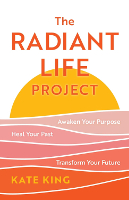
Image by Dan Cross
If there’s one phrase in the English language that has both befuddled and enraged people for generations, it’s let it go. It infuriates us because despite our deep longing to do such a thing, letting go remains elusive and always seemingly out of reach. The culprit? Our thoughts and the narratives they build within us.
Letting go is incredibly difficult for two reasons: First, we tend to avoid letting go of something we have grown attached to, and many of the stories we tell ourselves are quite embedded within the picture of who we believe ourselves to be. To let go of them risks our losing sight of who we are, and that’s scary.
For example, let’s look at the narrative I’m a fun person! I’m always up for a good time. Releasing this narrative would require reorienting certain relationships, community, and a socialite personal identity, which could result in loneliness or exile.
Secondly, it is difficult to let go when we feel that our narrative is protecting us in some way. If our narrative serves to keep us away from heartbreak, failure, or any other such emotional demon, it could be tough to let it go. For example: Men can’t be trusted. They’ll just use me and break my heart.
Letting go of this narrative means putting your heart on the line and risking the vulnerability it takes to find lasting love. If you surmount your fearful narrative, you could get hurt, and if you get hurt there’s no guarantee the whole shebang would have been worth it.
Why Let Anything Go?
Why in the world would anyone ever let anything go if it carried such risk and insecurity? I’ll tell you why: Ultimately, when we don’t let go of the fears, obstacles, resistance, and rigidity in our lives, we suffer more than we would have if we had never tried in the first place. This is because we are expressive creatures, and our cultivation of a radiant life includes the risk and reward that comes with vulnerability, openness, and surrender.
Releasing internal dialogues that keep us stuck and complacent frees us and opens new possibilities for how we see ourselves, our world, and our place in it. When we successfully set free the narratives that hold us back and make us small, it is as though we have exchanged our colored lenses with clear ones. We can then see things as they actually are without the charge or trigger our storytelling has attached to them. In so doing, we learn to see ourselves as a part of something larger, something wildly profound and impossible to understand in singular dimension. This is akin to how the ocean must witness a wave without attaching to its form.
The Detriments of Attaching to Our Thoughts
One teacher who speaks beautifully about the detriments of attaching to our thoughts is Eckhart Tolle, and particularly so in his book A New Earth: Awakening to Your Life’s Purpose. In his writing, Tolle explains that the most significant reason for our suffering is never the situation itself but our thoughts about the situation—our attachments, emotional reactions, assumptions, and narratives.
If we open awareness to our bubbling thoughts, and separate them from the present situation, we will see that the situation itself only exists as everything always does without the attachment of narratives—neutral. Even if we get caught in a tailspin of emotions in reaction to a story about a situation, it’s important to remember that emotions themselves are not bad, wrong, or negative—even the tough ones. As Tolle says, “Only the emotion plus an unhappy story is unhappiness.”
The Gateway to Peace
When we truly let go of our attachment to what happened, is happening, or could potentially happen, we are left only with what is. Such presence is the gateway to peace because it is embodied in the richness of the moment, with all its gifts. From such a perspective, we can be much clearer about whether we must take action, surrender, soften, or respond.
It is a fallacy of the human mind to believe that worry and stress empower us to change the circumstances of our lives. In reality, if we have been awake to our life and taken aligned action, whatever happens next is out of our hands. I have an easier time trusting the power of such surrender when I remember this quote from the great Indian philosopher and spiritual teacher J. Krishnamurti: “This is my secret. I don’t mind what happens.”
Knowing that detachment from our narratives is important is quite different from integrating that knowledge into lived experience. It is certainly a process, and we must be kind to ourselves when we engage this work. Especially when working with deeply embedded narratives that have grown into core beliefs, take the long view. Simply begin to notice each time you operate from a particular narrative; notice what triggers it, how you habitually respond, and any impulses connected to it. With awareness and patience, you will bring consciousness to your story and begin to shift it.
An Embedded Narrative: I Am Difficult
One such embedded narrative I spent much of my life believing is that I am difficult. The story first developed as a response to external relationships when I was a child. Over time and with repetition, I began to notice more acutely that when I showed strength, independent opinions, or inserted personal boundaries, the word difficult kept coming up in reaction to me.
Voicing my thoughts and feelings and being strong or honest directly opposed the flow in certain relationships. These people much preferred that I shut up, fit in, and be easygoing. My adherence to the narrative that I was inherently difficult (meaning something was wrong/bad about me), taught me that I should hide my true Self away and prevent others from knowing the strength of my nature. I became hypersensitive to the relationships that preferred I remain compliant and quiet, and unintentionally disregarded those who respected and appreciated my strength.
In an effort to protect myself from seeming difficult, I learned to play small and hide my voice. Go with the flow I’d say to myself. Just deal with your discomfort. It will feel worse if you speak up and they think you’re difficult.
Well, it worked until it didn’t. At that point, I realized that the energy it took to hide my strength wasn’t worth it anymore. With this understanding, I intentionally worked toward letting go of the narrative that didn’t serve me—the one that had been a core belief about how I needed to behave in order to achieve love and belonging.
Letting Go of Our Stories About Ourselves
Letting go of our stories about ourselves is a process. Especially with deeply rooted narratives that have grown into belief systems, this type of release requires patience and deliberate intention.
Surrender sounds like an easy process when you visualize a person allowing themselves to be carried by the current of a flowing river (this is the mental image I always have for surrender). The truth is, the river of surrender has branches and boulders scattered throughout, and it’s easy to get snagged.
Letting go is easiest to achieve when you get so sick of your own narrative (and the icky feeling that comes with self-abandonment and betrayal) that you just cut the cord and free yourself. It is similar to the experience of giving up, but instead of feeling defeated you feel liberated. Giving up on something you care about and truly desire comes laced with guilt and remorse, but saying goodbye to a pattern that holds you back might be one of the most healing experiences a human can have.
Offering: Explore the differences between surrendering and giving up in your journal. List three examples of surrender, and three of giving up. Then write a few sentences about the differences you notice.
The Grief of Letting Parts of Yourself Go
If you are not at the point where you are devastatingly sick of your own garbage but you still want to work on letting go, do yourself a favor and kiss your outdated narratives goodbye. Just as a heavy jacket feels stifling and weighty in the heat of summer, so do the distorted and unhealthy stories we tell ourselves once we tread the path of growth and healing toward our radiant lives.
It’s worth mentioning that you may feel grief when you shed outdated narratives and parts of yourself that no longer serve you. Like the death of a loved one, the absence of something that has become a steady psycho-emotional companion for a long time can leave a hole—even if you’re better off without it. It’s okay for it to feel odd, awkward, or even painful.
The loss of a faulty narrative is still a loss, and sometimes what sticks to our heartstrings is unpredictable. If you find yourself experiencing grief related to your growth process, meet yourself with gentle kindness.
Copyright 2023. All Rights Reserved.
Adapted with permission of the publisher.
Article Source:
BOOK:The Radiant Life Project
The Radiant Life Project: Awaken Your Purpose, Heal Your Past, and Transform Your Future
by Kate King.
 A groundbreaking guide for self-healing enthusiasts that teaches a fresh therapeutic approach for a meaningful life by combining science, creativity, psychology, and insightful personal growth tools.
A groundbreaking guide for self-healing enthusiasts that teaches a fresh therapeutic approach for a meaningful life by combining science, creativity, psychology, and insightful personal growth tools.
The common problem in our society is precisely this: We are not as alright as we seem. Trauma, physical and mental illness, and disembodied value systems are at an all-time high across our communities. Additionally, issues of pervasive social justice imbalances, inequality for marginalized communities, and painfully charged political dynamics clearly demonstrate a large-scale desire for collective change and transformation. Society is waking up to a new reality without the shackles and numbness that have previously limited our potential. This book is the timely resource to support the expansive elevation humanity demands.
The Radiant Life Project answers the yearning for large-scale repair with the intention of mending the world by first cultivating radical wellbeing within each individual. This book teaches a fresh and accessible approach to self-healing with deep compassion, skillful expertise, and exquisite strategies for intentional progression toward improved mind-body-soul wellness.
For more info and/or to order this hardcover book, click here. Also available as a Kindle edition.
About the Author
 Kate King is a licensed professional counselor, board-certified art therapist, radiant life coach, published author, professional artist, and creative entrepreneur. She teaches a unique transformational healing strategy that integrates science, psychology, creativity, and spirituality.
Kate King is a licensed professional counselor, board-certified art therapist, radiant life coach, published author, professional artist, and creative entrepreneur. She teaches a unique transformational healing strategy that integrates science, psychology, creativity, and spirituality.
Her new book is The Radiant Life Project: Awaken Your Purpose, Heal Your Past, and Transform Your Future (Rowman & Littlefield Publishers, Nov. 1, 2023).
Learn more at TheRadiantLifeProject.com.

























